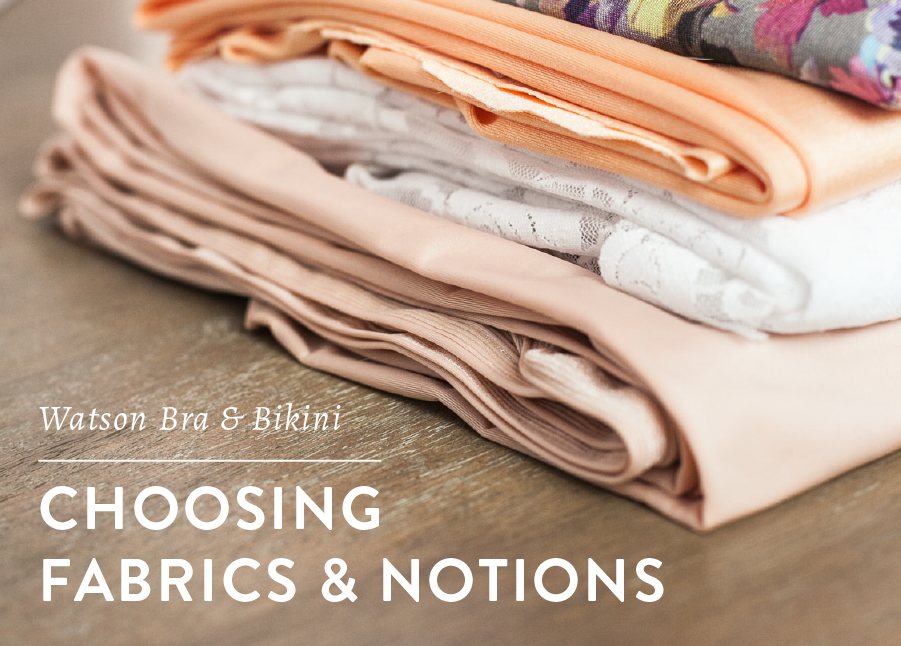
Today I want to talk a little bit about selecting fabrics for the Watson and I’ll share a few examples from my own projects.
I know that shopping for lingerie fabrics and bra-making supplies the first time around can be a little bit overwhelming, but it doesn’t have to be. Bras in particular use a few materials that you may not ordinarily use in other garments, but these aren’t difficult to find. Little amounts also go a long way, which brings me to a few suggestions as you go shopping:
- Stash. Once you make a bra or two, there’s a really good chance you’ll have extra lining and elastic which make gathering materials for the next project much easier. Stashing linings and a few elastics for lingerie is just as useful as stashing zippers, thread and interfacing for other garments.
- Neutral colors are your friend. Shop for neutral-colored elastics, hardware and linings and mix them into your sets. Neutrals can be black, gray, nude-ish colors, or even white. These colors are also easier to find. A nude lining or powernet works underneath most fabrics. I use nude mesh and linings for many bras that have bright colors as their main fabrics.
- Mix and match. I like to think about the elastics and the hook & eye as accents. Instead of trying to get all matchy-matchy, I save myself the frustration of finding matching hardware and buy (or dye) the elastics in bright colors that might accent or contrast with my main fabrics.
- Dye. This is my personal tactic in making lingerie: I buy all my elastics and lining materials in white and in enough yardage for several bras and then I dye them before a project. Obviously that adds an extra step, but I have gotten fast at this step and have a stash of dye colors, so this is easier for me.
However you gather your materials, online shopping is the way to go, particularly with hardware and elastics. I’ve curated a list of supplies for the Watson on Etsy. And for even more ideas, I publish a very big list of bra and lingerie making resources.
Fabric Choices
The best fabrics for the bra cups are going to be a 4-way stretch lycra knit or stretch mesh. These fabrics tend to have quick and perfect recovery, which means they don’t loosen up or relax with wear. Some terms you might want to look for in lycra fabrics: 4-way spandex, lingerie lycra, milliskin (which comes in matte or shiny/satin), tricot lycra, satin lycra, or even swimsuit lycra.
Although I recommended 75% stretch, stores don’t often list the stretch percent of fabrics. I wouldn’t worry too much about getting this exact stretch. Several of my test fabrics had less stretch than that. A good general rule of thumb: if it is a knit, has at least 15% spandex, is sold as a swim, dance or lingerie fabric with 4-way stretch, then it’s got potential.
Here are two sets I made from lycra and stretch mesh. For the bands on both, I doubled the stretch mesh. Doubling a lighter stretch mesh is a great alternative to a firmer powernet.

On the left: matching milliskin and stretch mesh from Spandex House. On the right: stretch mesh from Fabric Depot Co.
On this bra I used stretch lace and a firmer powernet for the band. The bikini is made from stretch mesh.
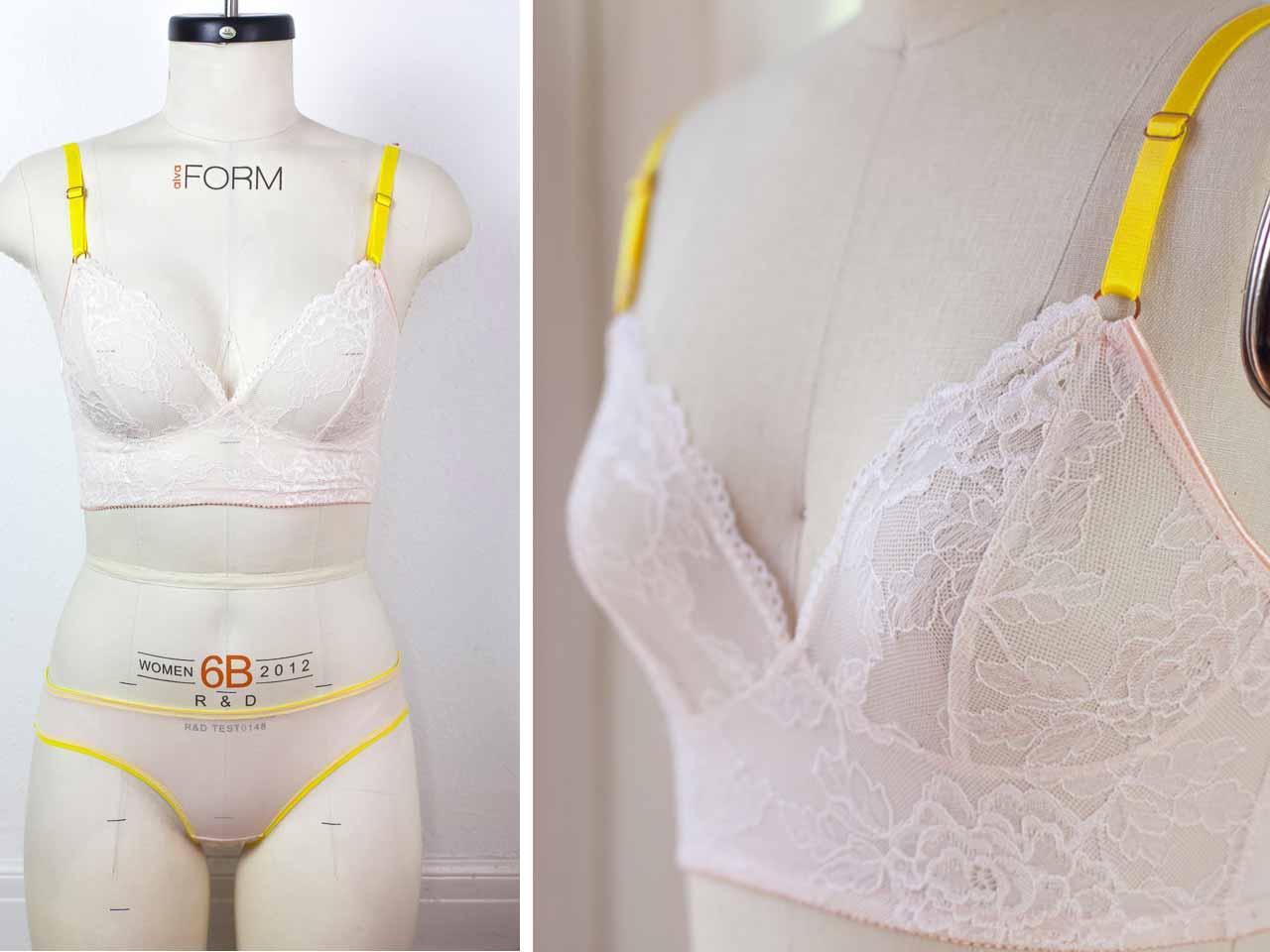
Stretch lace, Laceandtrims on Ebay. Powernet and stretch mesh, Fabric Depot Co.
If you want to use stretch lace, look for some with spandex content. Without the spandex, the lace won’t be supportive enough or it will “grow” in wearing.
It’s also possible to use natural fiber knits on the bra and bikini. A medium weight cotton/spandex jersey will probably be your best bet, since cotton tends to have a firmer fit. One of my favorite early makes of this pattern was a cotton knit Watson (which I snuck onto the blog over a year ago!). I still wear that bra a lot.
This is a version I made from a Tencel/spandex jersey as an experiment:
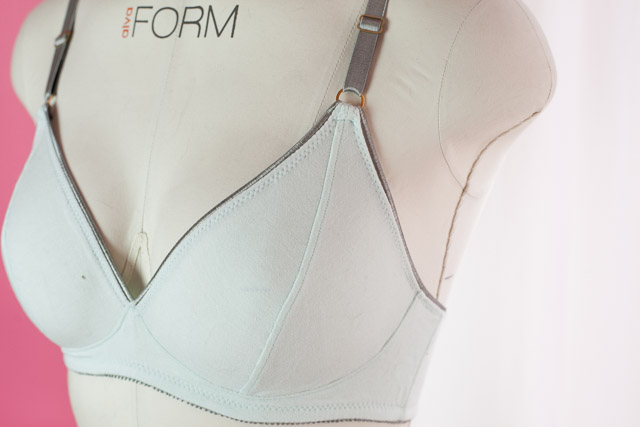
Tencel is a rayon and like all rayon jerseys this was a very drapey fabric that doesn’t have a lot of support. It also tends to lose its shape after awhile. This set turned out much bigger than others in the same size, so if making either the bra or bikini out of a rayon-type jersey, consider going down a size or taking in the cup seam.
Band Fabrics
Although I recommended powernet for the band, it is just a suggestion. And it isn’t always easy to find a matching color of powernet. If you want to use the same fabric on your band that you are using in your cups, you’ll need to reduce the stretch by doubling it as I did in some of the above samples or shortening your band piece.
While we’re talking about band fabrics, you might be wondering about those terms like stretch mesh, powernet, powermesh… what’s the difference?
Net and mesh are interchangeable terms for a fabric that that is knitted with an open hexagonal structure. Here’s a firm powernet on the left and a lightweight stretch mesh on the right:
Stretch nets and meshes come in all sorts of weights and “feel”. They can be very sheer, lightweight and drapey, or very tightly knit and firm in their stretch. The term powernet usually refers to a stronger weight, firm stretch mesh that’s good for bra bands. Usually the description will give you a hint as to how strong it is.
Elastic Choices
For the bra, you want to look for 3 different types of elastics:
- a plush back elastic for the hem
- a plush-back lingerie elastic for the top of the band and the neckline
- a strap elastic
Here’s a close-up of what a plush-backed elastic looks like:
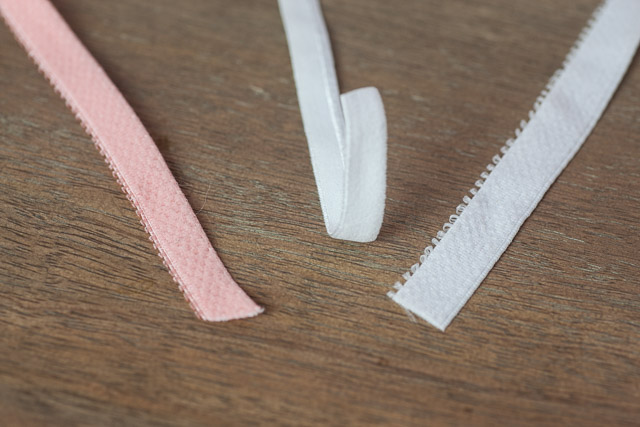
The bikini just needs your favorite lingerie elastic. It could be the same elastic you use to finish your neckline if you want to match!
Shopping for Fabrics
These are just a few options and ideas for your main fabrics:

Top Row: Lace Print lycra from Harts Fabric, Stretch Mesh from Spandex House, Taupe Dot on Black lycra from Girl Charlee. Bottom Row: lingerie stretch lace from Etsy’s MarynotMartha, Rainbow Stretch lycra from Tessuti, Lingerie Stretch fabric from Sewing Chest UK
If solids and matching sets are your game, Spandex House and Spandex World both carry matching milliskin and stretch mesh in tons of colors.
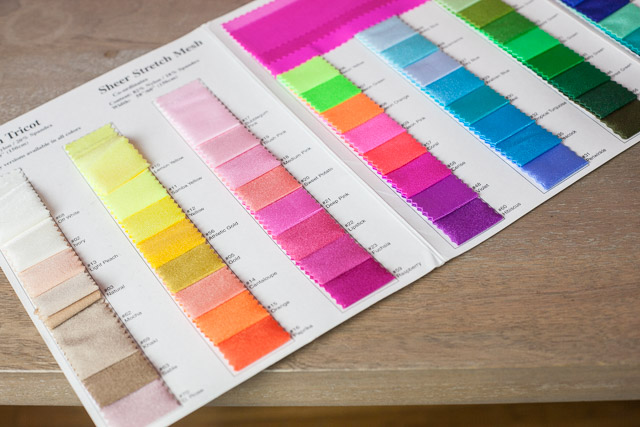
Shopping for Notions & Linings
For quality plush elastics, hook & eye and rings & sliders these are my favorites: Fabric Depot Co., Sewing Chest UK, Bra-makers Supply, Lace Heaven.
For linings: My favorite bra lining that I use for all bras is the sheer cup lining from Bra-makers Supply. It’s sheer but firm. You can also substitute 15 denier tricot or 40 denier tricot fabrics. These are very common and easy to find nylon lining fabrics (google them!), but keep in mind 15 denier is very lightweight. Alternatively, you may fuse a tricot knit interfacing. Any kind of fusible interfacing that works with knits and has a direction that doesn’t stretch is a good candidate.
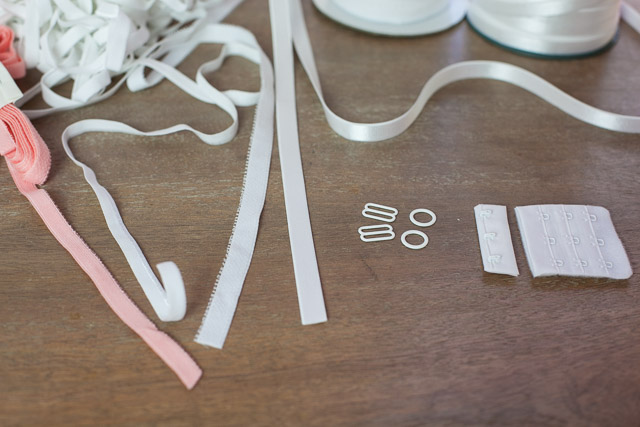
That’s it for today. I hope this guide has been useful and helps you understand how to choose your Watson materials. Happy hunting!
Would you like tips and inspiration in the craft of lingerie sewing? Sign up for my weekly eletter The Lingerie Maker.

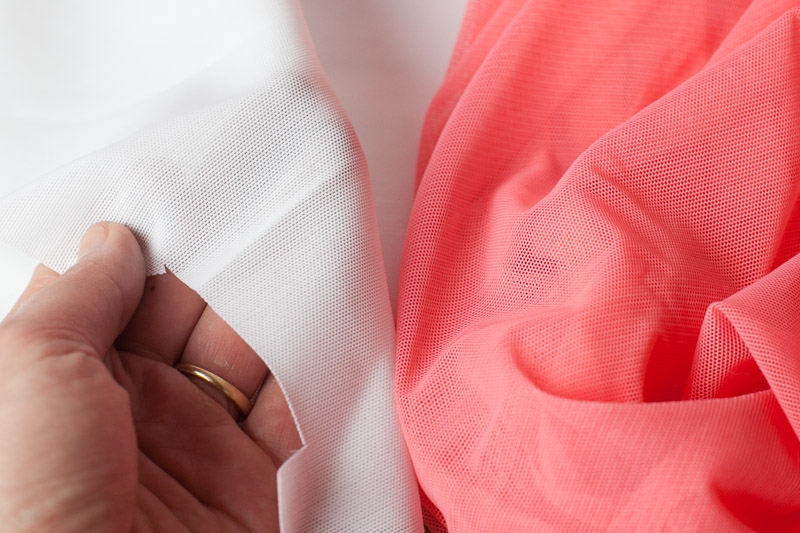
Merckwaerdigh also sells non stretch cup lining. It isn’t as sheer as the Bramaker’s lining but comes in a bunch of colors. It isn’t advertised in her shop but if you send her a message on Etsy she will make up an order for you. The last time I ordered it was less expensive than the Bramaker’s lining.
Btw love the Watson bra. In my opinion it is the best wireless bra pattern out there!
Thanks Anne!
A good bra lining is definitely stash-worthy, especially because a little bit goes such a long way…
Bad news ladies…
I contacted Merckwaerdigh, and she is no longer offering the cup lining as a single purchase. Kits only.
I’m fairly new to bra making but am loving it so far. I did have a quick question though – what’s the reason the they recommend plush back elastic over regular lingerie elastic for the bra? Is it just a comfort issue? Just wondering how big of a deal it would be to sub out the plush elastic for a lingerie elastic. Thanks! I just bought the pattern today and am so excited to get started!
It’s for comfort but also about strength. Plush backed elastic tends to be a little bit thicker and stronger and lasts longer. At the very least I would use it at the bottom of the band.
It’s seems to be some sort of requirement for bra supply websites to be very un user friendly. What’s up with that?
Hi Pam, I hear you, 100%. A lot of them were built with older web standards. It’s so much easier to build user-friendly web shops than it used to be!
Hello Amy,
I’ve never done a sew along. I am really looking forward to it! I have a few questions about Watson fabric:
Will the stretch laces I see that are, say, 8 inches wide work? I’m not sure they are four way stretch…or what the minimum width needs to be to get my (rtw 36E) pattern out of it.
Also, regarding the cup lining you like, from Bra Makers Supply, is it stretch? I am assuming we do need stretch. I cannot tell by the description on their website… Or maybe I am looking at the wrong stuff. Thanks so much! I am already enjoying the process!
Hi Andrea, the lining is for the cradle, not the cups. It should not stretch in at least one direction because you don’t want the cradle to stretch horizontally around the body.
For stretch lace trims, I would suggest a minimum of 6″ width but that also depends on the size of the cup pieces. Measure across the widest part of your cup pieces to find out. I think 8″ wide would definitely work for your size.
Stretch laces do vary hugely in how much they stretch and whether they are 2 or 4-way stretch. In my experience they don’t stretch as much as lycra so you may need to add more depth to the cup pieces, if that makes sense. Experiment!
So, you do not use lining for the cups at all? Or is it specifically for this pattern? I thought I read if you use very stretchy material for cups that are not supposed to stretch too much, you line them with less stretchy lining (like the tricot you mentioned). Is that true?
Zrinka – no lining in the cups. It’s true that lining reduces give in a cup that has stretchy fabric but the Watson is a different style than a form-fitting underwired cup. The cup is made for stretch knits and has some stretch reduction in the pattern.
I love the fabrics and pattern and I would love to try the Watson sew-along. However , although I have made slips and panties I have never made a bra nor have I ever used a downloaded pattern. I downloaded the free Rosy Ladyshorts pattern to see how a download pattern works and I saw the pieces are not printed completely ( due to the size of copy paper) so it appears I would need to choose a size , find and cut out the proper pieces and then tape the pieces together . I can’t invest in the pattern and fabric and then realize I can’t figure out how to make it. Therefore I am going to try making the Ladyshorts download pattern and see how that goes before I commit to the sew-along . Trying to make a Bra is tempting 🙂
Hi Barbara, for the Ladyshorts pattern you want to print all the pieces out, not just a few of them, and then tape them together to make one big pattern. After that you cut your size. There are a number of great tutorials online that can help make sense of how digital patterns are assembled. Sewaholic published one recently – http://sewaholic.net/how-to-assemble-pdf-patterns-quickly-efficiently/
The Ladyshorts pattern is only a few pages so it’s a good place to practice ;).
Thanks for all the detail you have put into this post. As I am a lingerie newbie, this will save me heaps of time and false starts sourcing what I need. Can’t wait – The Watson is gorgeous!
Hi,
I am so excited about your pattern that I rushed to the fabric district as soon as I was back in LA to get all the supplies. The reason I opted going downtown instead of buying online is that I like to feel the fabric before I buy. But since I never bought lingerie fabric/notions I got overwhelmed very quickly – not with the main/cup fabric, but with all the other stuff. The biggest problem for me was the powernet fabric… they showed me every imaginable thickness/ color (at least I think they did, you never know when you shop in the fabric district), but I still wasn’t sure which one to get. They were all quite stretchy, and I understand that for the front band you need something not stretchy? I know I am probably overthinking this, and it will be easier when I actually start sewing… Oh, and for some reason, the stores carry any imaginable color of fold-over elastic, lacy elastic and trim elastic, but finding plush strap elastic was a nightmare. I only found black and white. Strange. I am looking forward to the sewalong…
That sounds overwhelming! There are a couple of buyers here in Austin that go to the LA district and I’ve asked them about plush elastic and they said it’s harder to find. Sounds like a lot of what is sold is lightweight lingerie elastic and yes, fold-over elastic is probably the most ubiquitous, online and off. It also happens to be the flimsiest and not my favorite for bras (although I like it for underwear). It loses its stretch very quickly. This is why I suggested shopping online particularly from shops that cater to lingerie materials–some of those decisions are made for you, making it a whole lot less confusing! Then you get used to the feel of good materials and know what to look for when you go “off grid”.
My RTW is a 42 or 44 D or DD. Is the Watson sized to approximately that? I’m a newbie. I’ve made printable patterns before, but never a bra–and I’m not great at adjusting patterns. I make lots of clothes and have been sewing for 25 years, so I’m comfortable with the machine parts.
Love this style!
Hi Pamela, glad you love it!
I don’t know how this would compare to your personal bras as there are many measurements that go into bra drafting. But if the measuring chart in the pattern is way off from what you normally wear, then try your usual size and take it from there! Bras rely on a lot of details to fit well because they are so close-fitting, but it is really a worthwhile skill and you can definitely tackle it! But that said, this pattern is so much easier to fit since it relies on stretch fabrics, and there’s no underwire involved.
Thank you so much for the lovely website and blog. It’s one of the reasons I’ve started to sew bras and panties.
A couple of other great sites for sourcing:
1. Pacific Trimming – has pretty 1/2″ bra strap elastic and metal tone rings and slides.
2. Emma one sock – little pricey but has nice quality power net from Korea as well as 4-way stretch fabric (see Venezia)
3. For people who live in MA – Fabric Warehouse Basement – nice selection of “remnant” galloon lace at a real discount as well as some elastic trimming at a great price.
Hi Amy – thanks so much for this pattern, I’ve been wearing my “muslin” almost non-stop since I made it! And I can imagine having a whole drawer of them to choose from. My main problem will be sourcing the fabric (I live in NZ and would like to avoid buying from overseas if possible because shipping is rather expensive).
I did have a question about stretch lace – do you tend to buy yardage (as in, 110-150cm wide like normal fabric), or do you buy the more common, narrower strips?
Hi Sophie, that’s a great question. I buy both because I love lace!
When I am looking for stretch laces for any bra, whether it’s Watson or an underwired bra, I look for lace that that is knitted a bit more tightly. In other words, it shouldn’t be very open and flimsy.
When you are buying trim lace (aka stretch galloon lace), you’ll want to make sure that the lace is as wide as your cup pieces plus a couple of cm for extra cutting room. This will be different for every cup size, so measure across the widest part of your cup patterns to see how wide you need your lace needs to be. I’ll be doing a tutorial on cutting from galloon lace in the sew-along.
I am so down for the sew a long!! Been putting off bra making for too long now. I’m a solids kind of girl and all I want to know is who you ordered the swatch card from?! I need one!
Also happy about the dying lesson! can’t wait!
It’s from Spandex House
I cannot wait to begin sewing up the Watson bra and panties. YOu may want to direct your readers/followers/fellow sewists to Blackbird Fabrics. She, Caroline, is selling kits for the Watson, and has sewed up a few I believe herself. She loves this bra. Anyway, many thanks, and happy and a healthy new year! Annette
Hi Annett, Caroline and I have been in touch and I was going to share them here but she sold out of the kits very quickly. I’ll be sure to let readers know if these are sold again.
I love this pattern and can’t wait to try it! I’ve been looking at stores for a cute and flirty longline bralette style in my size, 38DD, and it just doesn’t exist. Thank you for putting this out there! I do wish the panties came a couple sizes larger though, (curse of the pear shape 🙂 I have several questions though…
I have this dreamy, buttery soft lyocell jersey. It feels amazing on my skin but I’m afraid it won’t hold up to the strain of a bra. I saw you used a rayon jersey for one model. Did you interface or line it at all?
Also, related to that, if I find that due to the fabric choice or the strain of my bust size, should I consider adding a thin foam padding?
Thanks 🙂
Hi Lydia, I have not tried foam in this bra. It may require some experimenting because there is a seam at the top of the strap that might interfere with foam. Since it is a stretch cup bra, the foam will change it to a non-stretch bra so you would need to play around with fitting the cups.
Lyocell is very soft! I did use it on one of the sets but it is the least supportive of all the fabrics, and as I mentioned turned out twice as big in the cups. Any type of rayon jersey (lyocell is a rayon) is going to relax on the body quite a bit. If support or coverage is of the utmost concern I’d definitely recommend a different knit.
Hi! I’m very excited about the sew along, but I’m kind of overwhelmed with the supply list. In other posts you’ve talked about FabricDepotCo’s bra kits. I was wondering if their kits have enough of fabric and other supplies for the Watson?
thanks!
Hi Sophia, I haven’t tried all of their kits. The ones I used in the past did not have enough stretch materials for the Watson. The main material is a non-stretch bra cup fabric. Blackbird Fabrics is selling kits for the Watson but they are selling out fast.
I am so excited to do this sewalong! I am having a problem finding the right elastics though. In most of the pictures of your finished Watsons, the neckline elastic has this pretty satiny almost piping feel to it. I really want to get that exact elastic but pictures on fabricdepotco and other suppliers aren’t the best. Could you list the style number/name of that type of elastic?
Hi Julia, this is my favorite elastic to decorate necklines. I purchased this particular elastic at Fabric Depot Co. in white and I dyed it. Sadly, I bought the last of their stock, and the store owner told me she no longer carries it. You can also try sewsassy.com. They sell a type of piping elastic with a satin edge in several colors. I’ve seen it on Etsy a few times, but can’t remember which store, so you might want to search “piping elastic” or “rolled edge elastic”.
Would a woven, such as silk organza, work for the cradle lining? Or does it need to have some stretch in one of the directions?
Hi Amy,
I just made my first Watson and really love it. A couple of questions: Is it important that the cradle doesn’t stretch? Could I use power net in place of lining? I found the cradle on mine to be ultra firm (I used a non-stretch lining from a kit) and am wondering if it’s totally taboo to have a tiny bit of stretch in the cradle. Also, when using a stretch lace should I line the cups or leave them as is? Trying to learn as fast as I can but there’s a lot to take in.
Thanks!
Hi Bella, those are really good questions. It depends on how firmly you want the bra to fit. A non-stretch lining is going to keep the cups a bit more stable. When you substitute stretchier fabrics this will make the band and cradle looser and possibly change the way the cups sit. The stretchier the powernet and lining, the looser everything will get. If you’re okay with a looser fit, then go for it!
The cups were designed to stretch in both directions so the more you remove the stretch (by lining or using a less stretchy fabric), the less “volume” you’ll have in the cups. Try putting your lining and lace fabric on top of each other and testing their stretch together. Do they have the stretch the pattern calls for? Most likely they won’t. In that case you may need to go up a cup size or two just to give yourself more volume.
I know that this might seem like a lot to take in. Bras are technical garments! Thankfully the Watson is a little less exacting in fit unlike a wired bra, so it’s easier to play around with fabrics. Over time you’ll develop a feel for the fabrics you like, and how to adjust the pattern to accommodate those fabrics for the fit you want!
Hi Amy,
I have been a silent follower of your blog. I have learnt a lot from you and am waiting eagerly for you to offer a class. Recently, I have been trying to find ways to finish necklines where I do not have scalloped edge. I see that you mentioned using narrow elastic on the inside to do that. Any online shop that you use to get narrow elastic? Also, do you know when you will be offering the class?
Thanks for being an awesome blogger!
Sohini
Hi Sohini, thank you so much for your kind comment. I am working on the online class! I hope it will be offered early in the new year. I have to work out some kinks in video but I will be announcing as it gets close!
The narrow elastic I often use in my necklines comes from Merckwaerdigh. (Links to her shop are on my supplies page.) I wrote her and asked if she would sell me the elastic separately as it was not in her shop. Unfortunately I not been able to find another source—specifically of narrow delicate elastic that dyes well (because I dye it!).
Hi Amy!
I’ve been kind of obsessed with the idea of making my own bra for a while now. I love my boobs and want them to have the best garment to rest in anyone could possibly conjure up. So I’ve been looking at and talking about boobs all the time, searching the internet for the best bra pattern I could possibly find. And I finally settled on the Watson bra. It seems so comfy! I bought it and now I’m measuring my fabrics for elasticity. I’ve been given some fabric scraps from a designer and I’d really like to use them for my bra. The fabric is 48% cotton and 52% viscose and has a 24% stretch. Will this fabric be too firm? And if so, what changes should I make for an optimal fit? Go up a size? I will make a muslin first so I’m sure I’ll find out what’s wrong with using a too firm fabric but if you have a tip on how to make it work without having to create two muslins just to get the fit right that would be awesome. I’m a 75C (32C).
Thank you for having such and awesome blog and for the amazing pattern.
Hi Emma!
If you are new to bra making I definitely recommend following a pattern’s recommended fabrics and techniques first, just to avoid frustration, and then trying alternative fabrics once you understand the basics and how a bra is designed to fit.
The fabric you described sounds like a woven fabric which I don’t really recommend for the Watson. Going up a size probably won’t help the fit since it was drafted to fit with knits that stretch in both directions and rebound well. (Wovens don’t have the same two-direction stretch.) Once you’ve made it a couple of times you’ll get some ideas on how to create a bra from your fabric but it might end up being a different pattern. 🙂
I have skin allergies to nickel, spandex, rayon and something in the elastic used in cacique bras. I end up with skin rashes. Even 5% spandex mixed with cotten leaves me with a rash. Unfortunately, my large bust (44DD at the moment) makes it difficult to find bras that fit. Sewing my own might be the perfect solution. Can the Watkins bra be made in 100% cotton? Would another bra style be more appropriate? I’m looking for a large band to hold in the sides, provides support for the breasts, and doesn’t use underwires. Any recommendations on where to find a good quality cotton material?
Hi Theresa,
Ouch, that doesn’t sound fun! Since you have allergies that eliminate most of what creates stretch, I would definitely recommend another style of bra than the Watson. It relies on stretch for most of its fit. A bra can certainly be made from 100% cotton but it would work best wtih a pattern that doesn’t use stretch in the cups and you would probably need to create a band pattern from something other than an elastic fabric. For your needs I would definitely invest in a good bra making book to learn about the various fabrics and pattern styles. It would be worth it to create comfy bras that you can’t find in stores!
Thank you, Amy. Your replies to myself and to Emma have helped me feel a little less lost. I’m following your advice about finding a good bra making book, and have asked a retired Home Economics teacher for advice. I hope you are able to develop an on-line class because you are very knowledgeable and supportive. Best of luck to you!
Theresa H
Hi there, I know this is a super old post, but hopefully you see my question. I am wondering if a cotton jersey would work for this pattern, like the kind used to for t shirts. Ive also found 4 way stretch polyester, is that the same as Lycra/spandex? Sorry for the noob question, but I’m a noob 🙂
Hi Jaime,
These posts are still active!
I often make Watson out of cotton jersey. I mention this in this post under the heading “Fabric Choices”: for best results use a medium weight (not to light like thin t-shirt fabric) jersey with spandex. The more spandex the better, since natural fiber jersey relaxes and loses its shape quickly.
A 4-way stretch polyester or nylon is basically the same fabric this bra was designed around, so you are good there. Is it bathing-suit weight? That would be perfect! Just be sure to check its stretch percent to make sure it is close to the pattern’s recommendations. The more you sew with knits the more you will learn that every material behaves differently and fits differently so try both to see which you like best!
Amy
Thank you for the reply Amy, the jersey I found says 5 % spandex and stretched 50 % in one direction and 100 % in another, so maybe I shall stick to the Lycra, it doesn’t specify swim weight or anything like that, just says “4 way stretch lycra”. I am super excited to try this pattern out, so maybe I shall take the risk and get the lycra unless i find something that specifies swimsuit weight.
Hi Jaime,
The stretch percent of the cotton you found is very typical of cotton/spandex jersey. If you wish to try it at some point, you may want to use a smaller cup size than the size you cut for a lycra fabric. (That’s what I do.)
For lycras, an online retailer usually won’t specify “swimsuit weight” but *most* of the time, something described as 4-way stretch lycra is good enough! Here’s a tip I’ve learned along the way: if an online shop happens to mention the lycra’s weight in ounces, I usually look for something that is 7 oz or more for the Watson. (7-9 oz per yard is about medium weight lycra. 5 oz. or less is usually thin and used for linings.) Anyway, you’re on the right track!
Amy
Hi Amy! I’m excited to delve into making my first Watson – I just started bra making (with the Orange Lingerie Boylston) and am still figuring out the whole materials rigamarole. I understand the findings/elastics/stretch laces and the role of cup/bridge linings etc, but I’ve been having a bear of a time finding a good stretch mesh.
I am little up top so don’t need the support of a medium powernet – I really would love to find a stretch mesh that I can use for this bra/panty set as well as with some other designs. Fabric.com has a few stretch mesh options (and their customer service is NO help in answering questions): would you suggest either(/neither)
https://www.fabric.com/buy/uk-955/telio-stretch-nylon-shaper-mesh-nude
or
https://www.fabric.com/buy/0462914/telio-stretch-nylon-mesh-knit-nude ( I thiiiiink this is closer to what I’m looking for?)
I purchased a few remnants of powernet from Joann’s that ended up being WAYYYY not the right thing, so I’m scared to purchase more and end up with junk again…
Help! Thanks!
Hi Susan,
Oh dear, I just found your comment in my “pending” section and apologize for such a late response (nearly a year later)! The service I used to notify me of new comments is no longer available. 🙂
I’m sure (hope!) by now you’ve tried a few fabrics. While I haven’t tried either of those fabrics you have linked to, it looks like the 2nd would be more suitable for the cups of the Watson.
In the pattern I recommend fabrics with 75% stretch and both of those have a bit less. The first only has 30% stretch which tells me it has more of a ‘powernet’ weight. Any time you see the term “shaper” it usually means it’s good for bra bands or firm shaping garments. It won’t be stretchy enough for the cups. The second choice may work! As with all stretch fabrics, you really do have to experiment till you find something that you like.
If it helps, the mesh I used in the samples (and subsequent versions for myself) for both the bikini and bras all come from Spandex World. Just look for stretch mesh and they have millions of colors, and often you can buy milliskin, which is the lycra I use, in a matching color.
Hi Amy,
Love your Watson bra pattern and the 2 I’ve made so far are incredibly comfortable AND cute! Now that I’ve used up the random elastics that I had in my stash, I’m ready to purchase some proper elastic but am confused about a couple of things:
1) The pattern calls for 1/2″ wide elastic for the straps- do you recommend this over 3/8″ width, and if so may I ask why?
2) Are plush-back (including picot) elastic and strap elastic interchangeable for use in the straps?
Thank you! Can’t wait to make a million more Watsons!!
Hi Katie,
Good questions!
1. You *can* use 3/8” strap elastic if you like. Narrower elastic looses its elasticity more quickly, just judging by my rtw bras with this width.
Also the narrower the elastic the more it digs in the shoulders so 1/2” and over are more comfy. If you are on the larger half of the cup range, I’d definitely stick with 1/2” or even 5/8” if you can find it. If you do use 3/8″, make sure that you can fold the top of a cup through a smaller ring, possibly by trimming the pattern there a bit.
2. Plush back elastic with decorative edges is best for edges but not so much for straps. Good bra strap elastic is a bit firmer—less stretch, if you will.
If you are having trouble making a distinction between the elastics, some of the sellers I list on my bra supplies page sell kits just with bra notions—elastic and hardware for straps and hooks.
https://clothhabit.com/bramaking-resources/
Hi,
I am unsure at where to use the 1/2″ and 1/4″ plush back elastic. And unfortunetly I cant find any in size 1/4″ in Sweden. Can i use only 1/2″ instead everywhere?
Thank you for your help!
I just bought your pattern and looking forward to make it 😉
Hi Babi,
The 1/4″ (6mm) elastic goes on the neckline of the cups (Step 5 in the pattern) and along the upper edge of the bra (Step 8 in the pattern).
Of course you can substitute other elastics if you like. But you need to keep these things in mind:
Any time you substitute a different width of elastic in a bra pattern that specifies elastic widths, you need to alter the allowance on the pattern. If you use a 1/2″ elastic where the Watson specifies 1/4″ without changing the allowance, some parts won’t fit together. (For example, the two cups won’t meet at the center front.)
For that reason, I highly recommend marking in your seamlines. That way you can see the exact line where the pattern is mean to be folded once elastic is sewn in. Once you know where that line is, you can add more allowance to the pattern for wider elastics. Please look through this post where I write about marking the seamlines and fold lines in your pattern: https://clothhabit.com/watson-sewalong-bra-fitting-alterations/
On the neckline, it’s best to use narrower elastics. A 1/2″ elastic on the neckline will be a bit bulky and possibly uncomfortable. If you can’t find 6mm, something like 8-10mm would be nice. Here are a few in Sweden: 10mm elastic and 10mm piping elastic. You may also want to search Etsy. It’s a great place to find elastic!